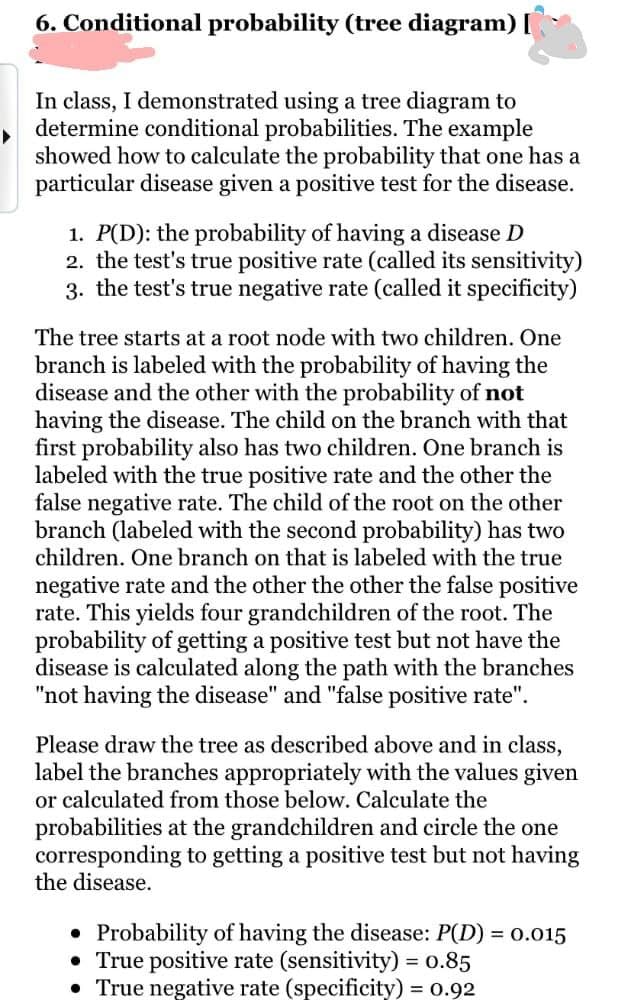or calculated probabilities corresponding the disease. from those below. Calculate the at the grandchildren and circle the one to getting a positive test but not having
or calculated probabilities corresponding the disease. from those below. Calculate the at the grandchildren and circle the one to getting a positive test but not having
College Algebra
7th Edition
ISBN:9781305115545
Author:James Stewart, Lothar Redlin, Saleem Watson
Publisher:James Stewart, Lothar Redlin, Saleem Watson
Chapter9: Counting And Probability
Section: Chapter Questions
Problem 2P: Family Planning A intend to have two children. What is tie probability that they will have child of...
Related questions
Question

Transcribed Image Text:6. Conditional probability (tree diagram) [
In class, I demonstrated using a tree diagram to
determine conditional probabilities. The example
showed how to calculate the probability that one has a
particular disease given a positive test for the disease.
1. P(D): the probability of having a disease D
2. the test's true positive rate (called its sensitivity)
3. the test's true negative rate (called it specificity)
The tree starts at a root node with two children. One
branch is labeled with the probability of having the
disease and the other with the probability of not
having the disease. The child on the branch with that
first probability also has two children. One branch is
labeled with the true positive rate and the other the
false negative rate. The child of the root on the other
branch (labeled with the second probability) has two
children. One branch on that is labeled with the true
negative rate and the other the other the false positive
rate. This yields four grandchildren of the root. The
probability of getting a positive test but not have the
disease is calculated along the path with the branches
"not having the disease" and "false positive rate".
Please draw the tree as described above and in class,
label the branches appropriately with the values given
or calculated from those below. Calculate the
probabilities at the grandchildren and circle the one
corresponding to getting a positive test but not having
the disease.
• Probability of having the disease: P(D) = 0.015
• True positive rate (sensitivity) = 0.85
• True negative rate (specificity) = 0.92
Expert Solution
This question has been solved!
Explore an expertly crafted, step-by-step solution for a thorough understanding of key concepts.
Step by step
Solved in 2 steps with 1 images

Recommended textbooks for you

College Algebra
Algebra
ISBN:
9781305115545
Author:
James Stewart, Lothar Redlin, Saleem Watson
Publisher:
Cengage Learning

Algebra and Trigonometry (MindTap Course List)
Algebra
ISBN:
9781305071742
Author:
James Stewart, Lothar Redlin, Saleem Watson
Publisher:
Cengage Learning

Algebra & Trigonometry with Analytic Geometry
Algebra
ISBN:
9781133382119
Author:
Swokowski
Publisher:
Cengage

College Algebra
Algebra
ISBN:
9781305115545
Author:
James Stewart, Lothar Redlin, Saleem Watson
Publisher:
Cengage Learning

Algebra and Trigonometry (MindTap Course List)
Algebra
ISBN:
9781305071742
Author:
James Stewart, Lothar Redlin, Saleem Watson
Publisher:
Cengage Learning

Algebra & Trigonometry with Analytic Geometry
Algebra
ISBN:
9781133382119
Author:
Swokowski
Publisher:
Cengage

College Algebra (MindTap Course List)
Algebra
ISBN:
9781305652231
Author:
R. David Gustafson, Jeff Hughes
Publisher:
Cengage Learning